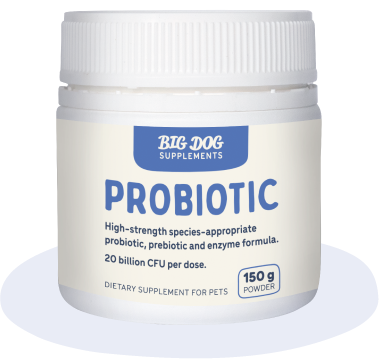How to choose the best probiotic for your dog

So, you've decided you want to give your dog a probiotic for all their amazing health benefits! But now it’s figuring out which probiotic is the best for your dog. Well don’t worry, because we’ve got you covered! Here are the top 5 key elements to look out for when choosing the best probiotic for your dog.
1. CFU’s

CFUs stand for colony-forming units. In simple terms, it indicates the number of viable cells per dose. This means you want to look for a higher amount of CFUs. Why? Well, studies show that 10 – 20 billion CFU is the most effective way to see a probiotic's benefits (2). It makes sense, right? The higher the strength, the faster and more effective the probiotic. This is also why Big Dog Pet Food probiotics have 20 billion good bacteria per 5g serve!
2. Number and variety of strains

The best probiotic for dogs is high-strength and contains host-specific strains, in this case, they are canine-specific strains. For example, Big Dog’s Probiotic includes 7 strains. Below is how each strain has a role in benefiting your dog's gut.
Enterococcus Faecium - Improves stress-related diarrhoea and reduces pathogenic bacteria.
Lactobacillus Acidophilus - Stimulates immune function, improves nutritional status and strengthens intestinal barrier (leaky gut) (2).
Bifidobacterium Longum - Reduces anxiety and helps prevent certain allergies (2).
Bifidobacterium Thermophilum – helps break down food, absorb nutrients and fights off “bad” organisms that might cause diseases (1).
Saccharomyces cerevisiae - Improves stool frequency and stool consistency, reduces symptoms of chronic enteropathies, reduces inflammation and improves nutrient digestibility (2).
Bacillus Subtilis – Reduces aggressive behaviour, improves digestion, immune system function and enzyme production (2).
Saccharomyces Boulardii - What’s unique about S. Boulardii is that it can’t be killed by antibiotics. It can be taken at the same time as antibiotic use to help protect the beneficial gut bacteria. It also helps reduce diarrhoea (3, 4).
This is only a brief outline on what each strain benefits, if you would like to read a more in-depth explanation, you can do so here.
So, to sum it up, if you find a long list of strains but low CFUs, the benefits of that probiotic will be less effective because the strength of each strain is not high enough to do its job. Containing 7 host specific strains, our Big Dog Pet Foods formula has been developed specially for canine health and vitality.
3. Digestive Enzymes

Digestive enzymes and probiotics have a complementary relationship. This is because digestive enzymes help break down your food, while probiotics support gut microbiome health. Both can support the body in combating bloating, supporting digestion, and strengthening the immune system. Taking them together may maximise their impact. So, keep an eye out for digestive enzymes with your probiotic.
Also, not to toot our own horn or anything here (but clearly, we are); at Big Dog Pet Foods we already have 5 digestive enzymes in our probiotic. Check them out:
- Alpha-amylase
- Protease
- Cellulase
- Lipase
- Pectinase
4. Microencapsulation

Microencapsulation is a protective layer that covers the probiotics and makes sure the good bacteria is released in the right place of the gut. Otherwise, if the probiotic is broken down in the wrong area of the gut, all its intended benefits are essentially useless! (5). Microencapsulation is important to look out for when selecting a probiotic to make sure that the probiotics make it to the gut to do their work.
If you want to know if your probiotic is microencapsulated, you can test it right at home! Put the tablet or powder form in a bowl of water, and if it floats, they are microencapsulated!
5. Prebiotics

Prebiotics are naturally occurring food components and are actually a source of food for the probiotics to grow and do their good work in the digestive system. It helps the probiotics to thrive and flourish while performing their other health–enhancing functions. So, if you see prebiotics listed in your dog's probiotic, you know that the probiotics are getting exactly what they need to effectively improve and maintain gut health.
We've already added a natural prebiotic - green banana powder!

To find the best probiotics for dogs, check out the Big Dog Pet Foods Probiotics for Dogs here. If you need help deciding which probiotic is right for your pet head here or see where you can purchase them here.
